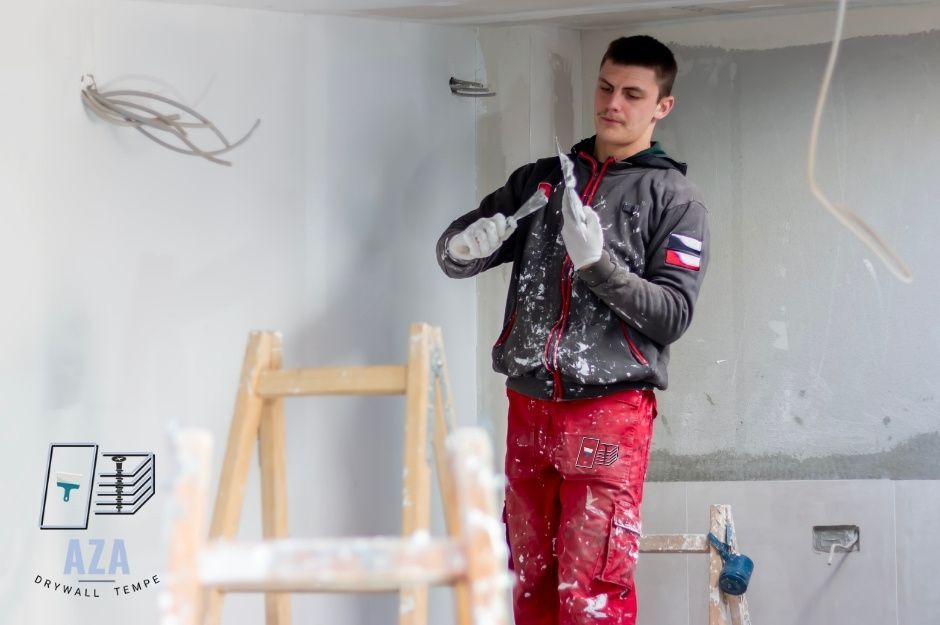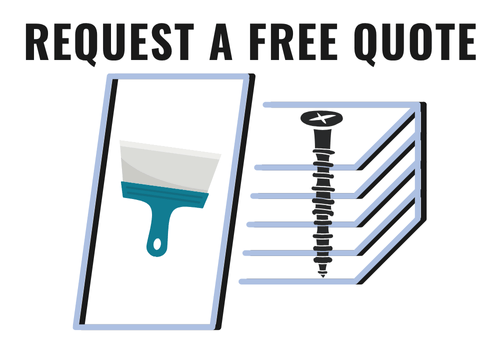Glendale Drywall Repair Services
Trustworthy Sheetrock Repair Contractors in Glendale, Arizona

Professional drywall contractors at Aza Drywall Tempe in Glendale, Arizona offer comprehensive repair and installation services to maintain and enhance your home's interior walls and ceilings. From small patches to complete installations, these skilled specialists tackle everything from nail pops and cracks to water damage restoration.
Your local Glendale drywall experts provide essential services including patch repairs, crack fixes, popcorn ceiling removal, ceiling repairs, hole patching, water damage restoration, new drywall installation, and professional finishing.
With Glendale's population of 248,325 spread across 65.1 square miles in Maricopa County, homeowners have access to experienced contractors familiar with the unique challenges of Arizona's hot desert climate. Given that Glendale experiences extreme temperatures ranging from record lows of 16°F to record highs of 122°F, proper drywall installation and maintenance becomes crucial for interior comfort and energy efficiency.
You can expect quality workmanship from Glendale's drywall contractors, who bring years of experience and technical expertise to every project. Many offer free assessments and quotes, allowing you to make informed decisions about your drywall repair and installation needs. Contractors serving areas from the historic Arrowhead Ranch neighborhood near Arrowhead Towne Center to properties along the Loop 101 corridor understand the specific needs of Glendale's diverse housing stock.

Aza Tempe Drywall (CP)

Comprehensive Drywall Repair Services in Glendale, Arizona
Professional drywall repair services in Glendale address a wide range of wall and ceiling issues, from minor cosmetic fixes to major structural repairs. In Glendale's hot desert climate (Köppen: BWh), where summer temperatures regularly exceed 100°F and the area receives only 7.22 inches of annual precipitation, drywall faces unique stresses from thermal expansion and low humidity conditions. Local contractors provide expert solutions using industry-standard techniques and materials to restore your walls and ceilings to pristine condition.
Drywall Patch and Hole Repair
Small holes from picture hangers require simple patching with joint compound and sanding. Larger holes need drywall patches cut to size and secured with drywall tape and mud. In Glendale's low-humidity environment, with average relative humidity of just 36.6%, joint compound and patches dry faster than in more humid climates, requiring contractors to adjust their application techniques accordingly.
Patch repairs follow a systematic process:
- Clean edges around damaged area
- Install backing support for stability
- Apply multiple thin coats of compound
- Sand between layers for smooth finish
- Match existing wall texture
Professional contractors carefully blend the repaired area with surrounding surfaces to create a seamless appearance. The final texture matching ensures your repair becomes virtually invisible. Contractors familiar with Glendale's building patterns, from older homes in the original town site bounded by Lamar Road and 59th Avenue to newer constructions near State Farm Stadium, understand how different eras of construction require specific repair approaches.
Crack Repair and Prevention
Drywall cracks often appear near windows, doors, and corners due to settling or temperature changes. Glendale's extreme temperature swings - with daily maximums reaching 106.5°F in July while minimums can drop to 45.3°F in December - create significant thermal stress that commonly causes drywall cracking. Early repair prevents cracks from expanding and causing further damage.
Common crack repair methods include:
- Surface preparation: Cleaning and widening the crack
- Reinforcement: Applying mesh tape for added strength
- Compound application: Multiple layers of joint compound
- Texture matching: Blending with existing wall finish
Your contractor will identify the underlying cause of cracks to recommend preventive measures like expansion joints or flexible caulk in high-stress areas. Given that Glendale sits about nine miles northwest of Phoenix in the Salt River Valley, properties may experience settling related to the desert soil composition, making proper crack assessment essential.
Water Damage Assessment and Repair
Water-damaged drywall requires immediate attention to prevent mold growth and structural weakening. Signs of water damage include discoloration, bubbling, and soft spots. While Glendale receives minimal rainfall - averaging only 33.4 precipitation days per year - the monsoon season from July through September can bring intense storms that may cause roof leaks or plumbing issues affecting drywall.
The repair process involves:
- Moisture testing to determine damage extent
- Removal of affected material
- Drying and dehumidification
- Installation of new drywall sections
- Finishing and texture matching
Professional assessment helps identify and address the water source before completing repairs. Contractors experienced with Glendale properties understand that water damage often occurs during the brief but intense monsoon period when average precipitation jumps to 0.91-0.93 inches in July and August.
Specialized Ceiling and Popcorn Ceiling Repairs
Ceiling repairs require specific techniques and safety measures. Popcorn ceiling removal modernizes your space while addressing underlying damage. Many Glendale homes built during the city's rapid expansion between 1950-1960, when the population nearly doubled, feature popcorn ceilings that homeowners now prefer to update.
The process includes:
- Protection of floors and furniture
- Safe removal of existing texture
- Repair of any discovered damage
- Application of new smooth finish
- Optional: Modern texture application
Ceiling repairs often involve working with overhead fixtures and electrical components, requiring experienced professionals for safe completion. Given that Glendale has invested heavily in tourism infrastructure, including the Westgate Entertainment District and the upcoming VAI Resort scheduled for 2025, many property owners are upgrading their interiors to modern standards.
Professional Drywall Installation and Upgrades
Professional drywall installation requires precise measurements, proper materials, and skilled expertise to achieve smooth, sturdy walls that meet building codes and specifications. Contractors serving Glendale must be familiar with Arizona building codes and the specific requirements for desert construction, including considerations for the area's extreme heat and minimal precipitation. A qualified drywall contractor handles every step from initial planning through final finishing.
New Drywall Installation for Residential and Commercial Spaces
Professional contractors evaluate your space to determine the appropriate drywall thickness and type based on your specific needs. In Glendale's climate, where summer temperatures average 95.5°F and sunshine averages 87% of possible hours annually, proper drywall installation helps maintain interior comfort and reduces energy costs. Standard 1/2-inch drywall works well for most interior walls, while 5/8-inch fire-rated drywall may be required for garages and commercial spaces.
Installation begins with careful wall framing inspection to ensure proper stud spacing and alignment. Your contractor will cut and hang sheets precisely, minimizing joints and maximizing stability. Properties near Luke Air Force Base or in areas that experienced Glendale's strip annexation practices of the 1970s may have unique structural considerations that experienced local contractors understand.
Professional teams use specialized tools and techniques to secure drywall panels, preventing future sagging or separation. They pay special attention to corners, electrical boxes, and other obstacles requiring custom cuts.
Drywall Replacement and Remodeling Projects
When remodeling, your contractor will safely remove existing drywall while protecting surrounding surfaces and structures. This includes proper disposal of old materials and preparation of the exposed frame. With approximately 8.4-9% of Glendale households lacking a car (slightly above the national average), contractors often coordinate material delivery and debris removal to accommodate clients' transportation needs.
Room additions and layout changes require seamless integration of new drywall with existing walls. Your contractor matches textures and finishes for a cohesive appearance. Many Glendale homeowners are upgrading properties in established neighborhoods, from the original Brethren temperance colony area to newer developments around the Loop 101 corridor completed throughout the city.
Custom installations like curved walls, soffits, or built-in shelving need specialized techniques and materials. Professional teams have experience creating these architectural features while maintaining structural integrity.
Planning and Preparation for Installation
A detailed site assessment helps identify potential challenges like uneven framing or moisture issues before installation begins. Your contractor will address these problems to prevent future drywall failures. In Glendale's desert environment, where the New River and Agua Fria River flow through the western extremities, contractors must assess potential moisture issues even in this typically dry climate.
Material selection includes choosing appropriate board types, joint compounds, and fasteners for your specific application. Professional teams calculate precise quantities to minimize waste. Given Glendale's location about 30 minutes from Phoenix Sky Harbor International Airport, contractors can efficiently source specialized materials from the greater Phoenix metropolitan area when needed.
Proper scheduling ensures minimal disruption to your daily activities. Your contractor coordinates with other trades like electricians and plumbers to maintain an efficient workflow.
Climate control and ventilation requirements must be met during installation for optimal results. This includes maintaining appropriate temperature and humidity levels throughout the process. In Glendale's extreme heat, where temperatures can exceed 114°F during peak summer months, contractors often schedule installation work during cooler morning hours or provide temporary climate control.
Expert Drywall Finishing and Texture Matching
Professional drywall finishing requires precise techniques to create flawless walls and perfect texture matches. Glendale's low-humidity environment, with dew points averaging just 40.1°F annually, affects how quickly joint compounds cure and how textures develop, requiring contractors to adjust their techniques for optimal results. Skilled contractors use specialized tools and proven methods to deliver seamless repairs that blend perfectly with existing surfaces.
Taping, Floating, and Sanding Techniques
Your drywall repair begins with proper joint taping. Apply self-adhesive mesh tape over seams and joints to prevent future cracking. In Glendale's dry climate, compounds may cure faster than in humid regions, so contractors must work efficiently and sometimes use extended-cure products.
Mix joint compound to the right consistency for a smooth application. Apply three thin coats of compound, feathering each layer out wider than the previous to achieve an invisible transition.
Let each coat dry completely before sanding. Use 120-grit sandpaper for initial smoothing, followed by 150-grit for final passes.
Essential Tools for Floating:
- 6-inch and 12-inch drywall knives
- Pan and mud mixer
- Sanding blocks and poles
- Drywall sanding screens
Texture Matching for Seamless Surfaces
Accurate texture matching requires careful analysis of your existing wall patterns. Take photos and make sample boards to test different techniques before applying to your wall. Homes in different Glendale neighborhoods - from the historic areas platted by William John Murphy in 1895 to modern developments near Desert Diamond Arena - feature varying texture styles that reflect different construction eras.
Common texture types:
- Orange peel
- Knockdown
- Skip trowel
- Popcorn ceiling
Mix texture material to match the existing density. Use proper spray equipment settings to achieve the right pattern size and consistency. Glendale's consistent sunshine (3,871.6 hours annually) and low cloud cover make texture matching easier to assess under natural lighting conditions.
Test spray patterns on scrap material first. Adjust air pressure and material flow until you achieve an exact match.
Final Steps: Skimming and Surface Preparation
Apply a skim coat to eliminate any subtle transitions between old and new surfaces. Use a wide knife to spread an ultra-thin layer of compound across the entire repair area.
Sand the skim coat with fine-grit paper until perfectly smooth. Wipe surfaces clean with a slightly damp cloth to remove all dust.
Check your work under strong lighting from multiple angles. Look for any remaining imperfections that need attention before painting.
Prime all repaired areas with a quality drywall primer. This ensures even paint absorption and a uniform final appearance. In Glendale's intense UV environment - with an average UV index of 7.0 and summer peaks of 11.0 - proper priming becomes especially important for long-lasting paint adhesion.
Choosing the Right Drywall Repair Contractor in Glendale
Selecting a qualified drywall contractor requires careful evaluation of their professional credentials and clear understanding of service terms. With Glendale's diverse economy - from agriculture along Loop 101 to tourism centers like State Farm Stadium and the upcoming Mattel Adventure Park - contractors should demonstrate experience with both residential and commercial properties. A thorough vetting process helps ensure quality workmanship and fair pricing for your project.
Evaluating Experience and Credentials
Look for drywall contractors with a minimum of 5 years of experience in the Glendale area. Check their Arizona state licensing status and verify current liability insurance coverage. Contractors familiar with Glendale's unique challenges - from properties near the former Thunderbird Field (now Thunderbird School of Global Management) to homes in the Arrowhead Ranch development - bring valuable local expertise.
Request recent local references and examples of similar repair projects they've completed. Professional contractors should readily provide photos of their previous work. Given Glendale's strategic location along Grand Avenue (Murphy's original diagonal road to Peoria) and major transportation corridors, contractors should easily provide examples from throughout the city's 65.1 square miles.
Check online reviews from platforms like HomeAdvisor and Yelp to gauge customer satisfaction. Pay attention to reviews that specifically mention the type of drywall repair you need.
Understanding Estimates and Service Guarantees
Request detailed written estimates that break down labor costs, materials, and project timeline. Professional contractors should conduct an in-person assessment before providing a quote. With Glendale households averaging 1.72 cars compared to the national average of 1.8, contractors should be flexible about scheduling in-home consultations to accommodate clients' transportation needs.
Make sure the estimate includes specific details about repair methods, materials quality, and surface finishing options. Ask about their dust containment procedures and cleanup policies. In Glendale's desert environment, proper dust control becomes especially important due to the frequent high winds and dry conditions.
Look for contractors who offer written warranties on both materials and workmanship. Quality drywall repair services typically provide 1-2 year guarantees on their work.
Discuss payment schedules and verify acceptable payment methods before work begins. Reputable contractors typically require a reasonable deposit with final payment due upon satisfactory completion. Contractors serving Glendale's growing tourism economy, including the industrial development spurred by Loop 303's completion in 2011, should provide flexible payment options for both residential and commercial clients.
